|
|
Avignon - the City of the Popes
Who does not know the worldwide known and very famous French small city Avignon? Already in the kindergarten, people learn to sing about Avignon and its famous bridge; As a student, one learns in the lessons of history that the Popes did not anymore reside in Rome but had their seat during 70 years in the Palace of Avignon. As a student one finally realizes that in Avignon there is a famous university. And by getting older, the interest for festivals, theatre and culture increases and one's attention turns to the world famous festival of Avignon. By this way, latest during the first holiday at the Côte d'Azur or in the Provence, a visit to the city of the Popes becomes due. Avignon is the capital of the Départments Vaucluse and with barely 100.000 inhabitants a middle sized small city. But the number of the daily visitors make the city appear much bigger than it actually is. Those who are on holidays at the Côte d'Azur are very soon in Avignon, as Avignon is located right at the French main motorway A7 from Marseille to Paris. From Nice there are approximately 250 km up to Avignon, thus trip of pproximately 2 hours; from Marseille one gets in one hour to Avignon. Thus, the city of the Popes is an ideal destination for a day excursion. History of AvignonAlthough Avignon did not get really significant until the presence of the Popes, its history goes far more back. No matter if greeks, Romans or other nations, all recognized the strategically optimal situation of Avignon. The city rises right from the Rhône-bank on a limestone rock, this is the reason why it always could be well protected and surrounded by walls. The first time Avignon got a great significance was when it was declared to a Roman colony. But after the Roman epoch, Avignon lost again its significance and, in the 6th century it was only a Burgundy military station. In the course of the time, Avignon developed to a significant economical centre, but it should still take half a millenium until Avignon became a world centre. 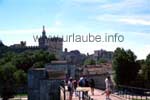
In the year 1305, Clemens V. from Bordeaux became Pope. Due to the political circumstances he refused to move to Rome and got settled in Avignon in the year 1309. His successor Johannes XXII. was already bishop in Avignon; he also refused to move to Rome. By this way, Avignon remained up to the year 1377 the centre of the christian church. Seven Popes resided during approximately 70 years in Avignon. The time of the Popes not only made Avignon to a world famous city but also provided an important economical boom. The Popes invested a lot of money in the expansion and beautification of the bishop palace to convert it to the Pope palace.The Rhône-bridge was expanded, a nearly 5 km long city wall was arranged and two small forts were built in order to protect the city; Numerous famous artists and arquitects were attracted by Avignon. During the time of the Popes, the population of Avignon grew from 15.000 to more than 50.000. Numerous immigrants hoped to obtain a social raise in a prospering city. 
After the seventh Pope of Avignon Gregory XI. returned to Rome, the end of the blooming period of Avignon came. But the city remained to be subject of the Roman church. The French Kings of the 17th and 18th century occupied the city several times by their military in order to connect it to their own territory. But up to the French Revolution,Avignon was not definetely included to France. Avignon could not be maintained any more by the catholic church that was continuously losing power. Today, Avignon is one of the most significant cities of France, not only because it is the capital of the Départment Vaucluse, but also due to its historical meaning, the thousnds of tourists who visit this city, the famous university and of course the World famous culture festival each summer. The City Wall of AvignonToday, Avignon is a middle-sized city with approximtely 100.000 inhbitants. By coming from the motorway, one first drives through the new and modern city quarters until getting somewhen to the city wall. The barely 5 km long wall is nearly completely conserved. 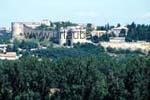
It was built during the time of the Popes in order to protect the city against some groups of bandits passing by. Right in front of the wall there was a wide fosse as additional protection. But it was actually filled up; on it, there is today the so-called ring road that surrounds the medieval core of the city. Alongside this street, there are numerous big parking places from which one can comfortably explore the city by foot. It is worthwhile in any case to drive alongside the barely 5 km long ring road in order to get an impression of the once very mighty fortress with the 7 city gates. Parking places in the oldtown as also a parking house at the market hall are available; but the trip through the medieval alleayways with a big car can become to a little adventure. The Pope PalaceIt is the Palais des Papes why millions of tourists do a side trip to Avignon. The Pope Palace is not a palace like beautiful castles are described, but the former bishop palace. The second Pope of Avignon, Johannes XXII. was a bishop in the closely locaed cathedral Notre-Dame and he simply reconverted the bishop palace to a Pope palace. 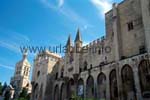
During the time of the Popes, the Palais des Papes was continuously rebuilt and expanded. For the first Popes, the plais was much too small and so they let the Palais Nouveau (new palace) built additionally to the Palais Vieux(old palace). Famous artists arranged an interior of the whole komplex that was congidned to a Pope. From the former pompous interior arrangement, today practically nothing is visible, as it was destroyed after the incorporation to France in the year 1791. 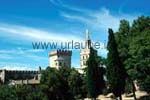
Of course, the view of the Palais des Papes belongs to the programe of a visit of Avignon. The Pope palace is either from the interior as also from the exterior impressive. Unfortunately, here is where the rip-off of the tourists begins in a way I have never seen it before. After the conquest of Avignon at the end of the 18th century, the palais was indeed converted to a prison for a short period, but the personnel of the palace still today behave as jailers. 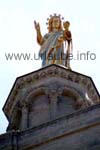
The rip-off starts with an Entrance fee of more than 10 € per person; Rucksacks and all kinds of stuff have to be left before entering the place. Although one principally only sees walls made of stone, the wards are very afraid of somebody taking something away despite of hundreds of monitoring cameras. I only wonder what this should be, a signpost or a pebble? Maybe they just want to avoid that someone makes a picture in the interior of the palace and destroys the stone walls with the flash light. No, here, the tourist rip-off continues: at the end of the round, one can buy some postcards to a completely overcharged price in order to take a souvenir. As impressive the big stony interiors of the palace might have been, I could not enjoy the tour as I was disgusted by the unfriendly personnel. I enjoyed much more the outer facilities of the place with nice views to the Rhône, the famous bridge and the Place de l'Horloge. The Bridge of AvignonThe second emblem of the city Avignon is, of course, the famous bridge named Pont d'Avignon. This is the way it is called thanks to the famous children song on which people dance. But in reality, the bridge is called Pont-Saint-Bénézet; Bénézet was a herdsman who was ordered by an angel to built this bridge in the year 1185. 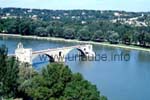
After all, this bridge resisted during half a millenium numerous storms, flood damages, flood waves and flood waters, before in the year 1660 a flood wave teared half of the bridge away. From the former 22 archs of the bridge, only four are left today. Also the chapel can be still viewed today. Of course, this is also not for free. For a fee of more than 4 € one can view the bridge and the chapel. But it is not worthwhile, as the bridge is also worthwhile to be seen from a distance. By standing on the bridge, one can see a little more of the river, but therefore there is no need to pay any entrance. Further Sightseeings in AvignonNumerous streets in the old Avignon end somewhere at the Place de l'Horloge. This plaza forms the centre of the public life of the city. Here are a lot of street musicians, conjurers, small item sellers, restaurants, cafés and of course thousands of people. One has a wonderful view to the plza from the walls of the palace. Also the rambling train that takes lazy tourists from sightseeing to sightseeing, does a stop at the Place de l'Horloge. 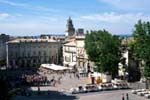
From this plaza, also the new main road of the oldtown starts, the Rue de la République, that leads exactly in southern direction right to the main station outside the city walls. Here is one restaurant after the next one; here, the tourist live booms and the prices too. Those who sit here in a street café in order to enjoy a coffee should first have a look to the card, as for the price for a coffee one gets a whole meal elsewhere. For those who can spend a little more time in Avignon I recommend also a walk at the other side of the Rhône. As only from here, one has the very best view to the Pope palace and the city walls. Those who have still time can view the cathedral Notre-Dame where to Popes found their last resting places. The Festival d'AvignonOnce a year, in July and August, Avignon becomes the world city of culture that is during the time of the festival. The festival was originally founded in the middle of the 20th century as a pure festival of theatre. But meanwhile,there is lso a lot of music and dance. During the time of the festival, Avignon is a vivid city the whole night through.One mainly comes across to young people loafing from one spectacle to the other. Of course, during this time of the festival, the hotels are overbooked. Those who want to visit the festival should either get accommodated outside the city or book an hotel much time in advance. The theatre and music performances do not only take place in the Palais des Papes but spread in the whole oldtown. At more than 100 different places, hundreds of bigger and smaller performances take place at the same time. There are numerous bigger spectacles that attract hundreds or thousands of spectators. But there are much more performances in the background where young artists perform. For this, they advertise with flyers during the day. Here, one can often see in a very early stage what will be made big some years later. General impression of the city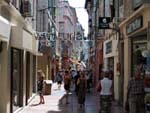
Avignon is a fascinating and pulsating city that is worthwhile to visit. Unfortunately, the city is overcrowded by tourists. And unfortunately, the restaurants, sellers, hoteliers and of course the city make use of this mercelessly. In no other city one is ripped off as a tourist as it is the case in Avignon, at least this is my personal experience. Only the completely overcharged entrance fee to the Pope palace and the prohibition of taking pictures is, as per my opinion, an unbounded cheek. Once I wanted to stay a night in Avignon but I did not get any hotel room. It was right so, as Avignon is a city that is perfect for a day excursion. In one day, one can view all the sightseeings and there is still some time left to afford an expensive coffee. Of course, this not only applies to July/August, as during the time of the festival, Avignon is really an absolute and unforgettable fun for young people. 



Copyright: Patrick Wagner, www.tourist-guide.biz |
||